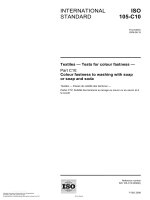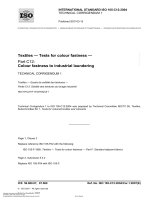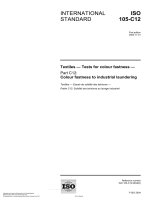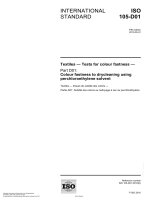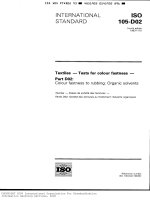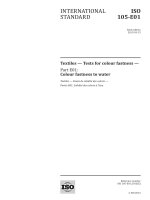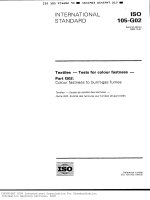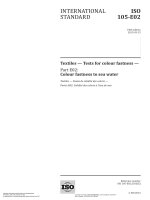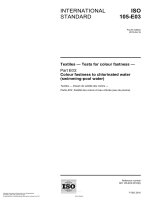Tiêu chuẩn iso 00105 c12 2004
Bạn đang xem bản rút gọn của tài liệu. Xem và tải ngay bản đầy đủ của tài liệu tại đây (130.97 KB, 12 trang )
INTERNATIONAL
STANDARD
ISO
105-C12
First edition
2004-11-01
Textiles — Tests for colour fastness —
Part C12:
Colour fastness to industrial laundering
Textiles — Essais de solidité des teintures —
Partie C12: Solidité des teintures au lavage industriel
Reference number
ISO 105-C12:2004(E)
--`,,,,``-`-`,,`,,`,`,,`---
Copyright International Organization for Standardization
Reproduced by IHS under license with ISO
No reproduction or networking permitted without license from IHS
© ISO 2004
Not for Resale
ISO 105-C12:2004(E)
PDF disclaimer
This PDF file may contain embedded typefaces. In accordance with Adobe's licensing policy, this file may be printed or viewed but
shall not be edited unless the typefaces which are embedded are licensed to and installed on the computer performing the editing. In
downloading this file, parties accept therein the responsibility of not infringing Adobe's licensing policy. The ISO Central Secretariat
accepts no liability in this area.
Adobe is a trademark of Adobe Systems Incorporated.
Details of the software products used to create this PDF file can be found in the General Info relative to the file; the PDF-creation
parameters were optimized for printing. Every care has been taken to ensure that the file is suitable for use by ISO member bodies. In
the unlikely event that a problem relating to it is found, please inform the Central Secretariat at the address given below.
© ISO 2004
All rights reserved. Unless otherwise specified, no part of this publication may be reproduced or utilized in any form or by any means,
electronic or mechanical, including photocopying and microfilm, without permission in writing from either ISO at the address below or
ISO's member body in the country of the requester.
ISO copyright office
Case postale 56 • CH-1211 Geneva 20
Tel. + 41 22 749 01 11
Fax + 41 22 749 09 47
Web www.iso.org
Published in Switzerland
ii
--`,,,,``-`-`,,`,,`,`,,`---
Copyright International Organization for Standardization
Reproduced by IHS under license with ISO
No reproduction or networking permitted without license from IHS
© ISO 2004 – All rights reserved
Not for Resale
ISO 105-C12:2004(E)
Foreword
ISO (the International Organization for Standardization) is a worldwide federation of national standards bodies
(ISO member bodies). The work of preparing International Standards is normally carried out through ISO
technical committees. Each member body interested in a subject for which a technical committee has been
established has the right to be represented on that committee. International organizations, governmental and
non-governmental, in liaison with ISO, also take part in the work. ISO collaborates closely with the
International Electrotechnical Commission (IEC) on all matters of electrotechnical standardization.
International Standards are drafted in accordance with the rules given in the ISO/IEC Directives, Part 2.
The main task of technical committees is to prepare International Standards. Draft International Standards
adopted by the technical committees are circulated to the member bodies for voting. Publication as an
International Standard requires approval by at least 75 % of the member bodies casting a vote.
Attention is drawn to the possibility that some of the elements of this document may be the subject of patent
rights. ISO shall not be held responsible for identifying any or all such patent rights.
ISO 105-C12 was prepared by Technical Committee ISO/TC 38, Textiles, Subcommittee SC 1, Tests for
coloured textiles and colorants.
--`,,,,``-`-`,,`,,`,`,,`---
ISO 105 was previously published in thirteen “parts”, each designated by a letter (e.g., “Part A”), with
publication dates between 1978 and 1985. Each part contained a series of “sections”, each designated by the
respective part letter and by a two-digit serial number (e.g., “Section A02”). These sections are being
republished as separate documents, themselves designated “parts” but retaining their earlier alphanumeric
designations. A complete list of these parts is given in ISO 105-A01.
iii
© ISO 2004 – All rights reserved
Copyright International Organization for Standardization
Reproduced by IHS under license with ISO
No reproduction or networking permitted without license from IHS
Not for Resale
ISO 105-C12:2004(E)
Introduction
without the addition of peroxy bleach compounds;
with the addition of hydrogen peroxide (for the bleaching of white work with coloured trimmings);
with the addition of sodium perborate tetrahydrate and tetra-acetylethylene diamine (TAED) (for the
bleaching of white work with coloured trimmings).
NOTE
The addition of TAED/perborate is a conveniently stable way of producing peracetic acid in situ.
This method of test does not reflect the effect of optical brightening agents.
This method and the single cycle test methods described in ISO 105-C06 and ISO 105-C08 may not
reproduce the effect of coloured fabrics treated with certain dye fixing agents and finishes after multiple
(5 to 10) industrial washes.
iv
Copyright International Organization for Standardization
Reproduced by IHS under license with ISO
No reproduction or networking permitted without license from IHS
© ISO 2004 – All rights reserved
Not for Resale
--`,,,,``-`-`,,`,,`,`,,`---
The test method in this part of ISO 105 is intended to reflect the effect of comprehensive laundering during
industrial laundry procedures, as distinct from the domestic washing test methods as given in ISO 105-C05,
ISO 105-C06 and ISO 105-C08. Four test conditions are described, one at (92 ± 2)°C intended for the
evaluation of workwear and three, as given below, at (75 ± 2) °C, for the evaluation of bed and table linen and
corporate wear:
INTERNATIONAL STANDARD
ISO 105-C12:2004(E)
Textiles — Tests for colour fastness —
Part C12:
Colour fastness to industrial laundering
1
Scope
This part of ISO 105 specifies methods for determining the resistance of the colour of textiles of all kinds
exposed to all forms of industrial laundering procedures.
One cycle approximates to the colour loss and cross staining resulting from chemical and/or mechanical
action achieved after multiple (5 to 10) industrial launderings.
2
Normative references
The following referenced documents are indispensable for the application of this document. For dated
references, only the edition cited applies. For undated references, the latest edition of the referenced
document (including any amendments) applies.
ISO 105-A01:1994, Textiles — Tests for colour fastness — Part A01: General principles of testing
ISO 105-A02, Textiles — Tests for colour fastness — Part A02: Grey scale for assessing change in colour
ISO 105-A03, Textiles — Tests for colour fastness — Part A03: Grey scale for assessing staining
ISO 105-A04, Textiles — Tests for colour fastness — Part A04: Method for the instrumental assessment of
the degree of staining of adjacent fabrics
ISO 105-A05, Textiles — Tests for colour fastness — Part A05: Instrumental assessment of change in colour
for determination of grey scale rating
ISO 105-F02, Textiles — Tests for colour fastness — Part F02: Specification for cotton and viscose adjacent
fabrics
ISO 105-F04, Textiles — Tests for colour fastness — Part F04: Specification for polyester adjacent fabric
ISO 105-F10:1989, Textiles — Tests for colour fastness — Part F10: Specification for reference adjacent
fabric: Multifibre
ISO 139, Textiles — Standard atmospheres for conditioning and testing
3
Principle
A specimen of the textile in contact with specified adjacent fabrics is laundered, rinsed and dried. Specimens
are laundered under appropriate conditions of temperature, alkalinity, bleaching and mechanical action such
that the result is obtained in a conveniently short time. The mechanical action is accomplished by the use of
an appropriate number of steel balls. The change in colour of the specimens and the staining of the adjacent
fabrics are assessed using the grey scale.
© ISO 2004 – All rights reserved
Copyright International Organization for Standardization
Reproduced by IHS under license with ISO
No reproduction or networking permitted without license from IHS
1
--`,,,,``-`-`,,`,,`,`,,`---
Not for Resale
ISO 105-C12:2004(E)
4
Reagents
NOTE
All chemicals should be of at least general purpose laboratory grade.
4.1
Detergent, as specified in Annex A.
4.2
Solution, containing 0,2 g/l of glacial acetic acid, if required for souring treatment.
4.3
Hydrogen peroxide solution, 30 %.
4.4
Sodium hydroxide (NaOH) pellets.
4.5
Tetra-acetylethylenediamine (TAED).
4.6
Sodium perborate tetrahydrate.
4.7
Distilled water, grade 3 water (see 8.2 of ISO 105-A01:1994)
5
Apparatus
5.1 Suitable mechanical device, consisting of a water bath containing a rotatable shaft which supports,
radially, stainless steel containers (75 ± 5) mm diameter × (125 ± 10) mm high of capacity (550 ± 50) ml, the
bottom of the containers being (45 ± 10) mm from the centre of the shaft. The shaft/container assembly is
rotated at a frequency of (40 ± 2) min−1. The temperature of the water bath is thermostatically controlled to
maintain the test solution at the prescribed temperature (± 2)°C.
NOTE
Other mechanical devices may be used for this test, provided that the results are identical with those obtained
by the apparatus described.
5.2 Mechanical stirrer, minimum (1 100 ± 100) min−1 or equivalent, to ensure dispersion and prevent
settling.
5.3
Steel balls, non-corrodible (stainless), approximately 6,0 mm in diameter.
5.4
Adjacent fabrics.
5.4.1
A multifibre adjacent fabric complying to type (TV) of ISO 105-F10:1989
5.4.2 Two single-fibre adjacent fabrics, one cotton and one polyester, in accordance with ISO 105-F02 and
ISO 105-F04 or as otherwise specified between interested parties.
5.4.3 If required, a non-dyeable fabric (e.g. polypropylene) (e.g. to mechanically stabilize a knitwear
specimen).
5.5 Grey scale, for assessing change in colour in accordance with ISO 105-A02, or instrumentally
ISO 105-A05, and for assessing staining in accordance with ISO 105-A03, or instrumentally ISO 105-A04.
5.6 Flat-iron, of mass not exceeding 2,5 kg (± 100 g) and capable of giving the temperature indicated in
7.2.5, if a pressing treatment is required. Condition the sample for 24 h before assessing to allow for
temporary colour change caused by heat.
2
Copyright International Organization for Standardization
Reproduced by IHS under license with ISO
No reproduction or networking permitted without license from IHS
© ISO 2004 – All rights reserved
Not for Resale
--`,,,,``-`-`,,`,,`,`,,`---
or
ISO 105-C12:2004(E)
6
6.1
Test specimens
Fabric specimen
Cut two fabric test specimens each 80 mm × 160 mm, one specimen in the warp direction and one specimen
in the weft direction. In the case of knitwear prepare two specimens. Weigh the two specimens to two decimal
places (grams). Fold each specimen across the narrow dimension in the centre of the specimen with fabric
face on the outside (see Figure 1). Using dimensionally stable thread, sew along the two sides to form a bag.
Place 25 stainless steel balls inside each bag and seal by sewing.
6.2
Adjacent fabrics
Either:
a)
cut a sample of multifibre TV adjacent fabric (5.4.1) and weigh to two decimal places (grams);
or
b)
cut a sample 100 mm × 80 mm, of the two single-fibre adjacent fabrics (5.4.2) and weigh to two decimal
places (grams).
NOTE
The two-fabric test specimen and adjacent staining fabrics are not sewn to each other. This allows fabric
abrasion to occur.
Dimensions in millimetes
Key
1
2
fold line
folded edge
3
folded specimen
a
Sew along two open sides.
Figure 1 — Preparation of test specimens
--`,,,,``-`-`,,`,,`,`,,`---
3
© ISO 2004 – All rights reserved
Copyright International Organization for Standardization
Reproduced by IHS under license with ISO
No reproduction or networking permitted without license from IHS
Not for Resale
ISO 105-C12:2004(E)
7
Test procedures
7.1
7.1.1
Preparation of wash liquor
Tests without the addition of hydrogen peroxide
Using the mixer (5.2), disperse 5 g/l of the industrial reference detergent (4.1) base powder (without optical
brightener) in grade 3 water (4.7) at ambient temperature for (10 ± 1) min. Add 1 g of sodium hydroxide (4.4)
per litre of solution. Using glacial acetic acid (4.2), adjust the pH to be within the range 12,0 to 12,5 and use
immediately. Proceed as in 7.2.
7.1.2
Tests with the addition of hydrogen peroxide
Using the mixer (5.2), disperse 5 g/l of the industrial reference detergent (4.1) base powder (without optical
brightener) in grade 3 water (4.7) at ambient temperature for (10 ± 1) min. Add 1 g of sodium hydroxide (4.4)
per litre of solution. Using glacial acetic acid (4.2), adjust the pH to be within the range 11,0 to 11,5. Add 2 ml
of 30 % hydrogen peroxide (4.3) and use immediately. Proceed as in 7.2.
7.1.3
Tests with the addition of sodium perborate and tetra acetylethylenediamine (peracetic acid)
Using the mixer (5.2), disperse 5 g/l of the industrial reference detergent (4.1) base powder (without optical
brightener), 2 g of sodium perborate tetrahydrate (4.6) and 0,3 g TAED (4.5) (100 % activity) in grade 3 water
(4.7) at ambient temperature for (10 ± 1) min. Using sodium hydroxide (4.4), adjust the pH to be within the
range 10,0 to 10,5 and use immediately. Proceed as in 7.2.
7.2
Testing the specimens
7.2.1 To each container (see 5.1) add wash liquor at a ratio of 15:1 liquor:fabric (i.e., 15 ml of solution for
each gram of combined specimen weight). Place both the prepared test specimens and the separate adjacent
fabric in the container together with an additional 25 stainless steel balls (5.3). Close the containers, place
them in the machine (5.1), commence rotation and raise the temperature at a rate of (1,5 ± 0,5) °C/min to the
temperature specified in Table 1. Continue to run the test for a further 60 min at this temperature.
Table 1 — Test conditions
Test number
Temperature
pH
Additions of bleaching
agents
1S
92 ± 2 °C
12,0 to 12,5
nil
2S
75 ± 2 °C
12,0 to 12,5
nil
1P
75 ± 2 °C
11,0 to11,5
2 ml/l of 30 % hydrogen
peroxide
2P
75 ± 2 °C
10,0 to 10,5
2 g/l sodium perborate
tetrahydrate
0,3 g/l TAED
--`,,,,``-`-`,,`,,`,`,,`---
NOTE
During the test, pressure may develop within the container. Containers should always be cooled and
the pressure released before opening.
4
Copyright International Organization for Standardization
Reproduced by IHS under license with ISO
No reproduction or networking permitted without license from IHS
© ISO 2004 – All rights reserved
Not for Resale
ISO 105-C12:2004(E)
7.2.2
Remove the fabric test specimens and the adjacent fabric(s) at the end of the wash and rinse twice
for 1 min in two separate 100 ml portions of grade 3 water (4.7), and then in cold, running tap water for 10 min.
7.2.3 Where the practice is to sour at the end of the washing operation, the following optional operation may
be conducted.
Treat the fabric test specimens in a 100 ml portion of acetic acid solution (4.2) for 1 min at 30 °C then rinse
each composite specimen in a 100 ml portion of grade 3 water (4.7) for 1 min.
7.2.4
Extract excess water from the fabric test specimen by squeezing.
7.2.5 Open out the specimens for measurement, by cutting along the seams. Dry the specimens and
adjacent fabrics by hanging in air at a temperature not exceeding 60 °C.
If required, press dry each specimen by pressing with a flat iron (5.6) at a temperature appropriate to the
fabric under test, but in no case at a temperature above 150 °C. Condition the specimen for at least 4 h at the
standard atmosphere for testing, as defined in ISO 139.
7.2.6 Assess against the unwashed fabric, the change in colour of the specimen and the staining of the
adjacent fabric, using the grey scale (5.5) or instrumentally.
Any change in colour at the fold line shall be visually assessed and commented on.
7.2.7 If agreed upon between parties, further wash cycles may be carried out on the same specimens in
order to simulate a greater number of industrial washes.
8
Test report
The test report shall include the following information:
a)
the number of this part of ISO 105, i.e., ISO 105-C12;
b)
the instrumental and/or the grey scale ratings for the change in colour of the specimen and for the
staining of the adjacent fabric(s) used;
c)
the test number used;
d)
whether the treatment in acetic acid solution described in 7.2.3 was conducted;
e)
whether the fabric test specimens were air dried or dried by pressing as described in 7.2.5 and if the latter,
the temperature of the pressing treatment;
f)
the number of wash, rinse and drying cycles carried out (see 7.2.7);
g)
all details necessary for complete identification of the sample tested;
h)
testing authority and date of testing.
--`,,,,``-`-`,,`,,`,`,,`---
5
© ISO 2004 – All rights reserved
Copyright International Organization for Standardization
Reproduced by IHS under license with ISO
No reproduction or networking permitted without license from IHS
Not for Resale
ISO 105-C12:2004(E)
Annex A
(informative)
Nominal percentage composition of detergent
A.1 Industrial reference detergent (without optical brightener)
The base reagent is composed of the following:
linear sodium alkylbenzenesulfonate (mean length of alkane chain C12)
0,425 %
nonionic surfactant: (C13-15, 7EO or C12-14 7EO)
6,0 %
sodium citrate dihydrate
5,0 %
HEDP – Na Salt (hydroxyethanediphosphonic acid)
1,0 %
anhydrous metasilicate
42,3 %
polymer (polymaleic acid)
2,0 %
foam inhibitor (phosphoric acid ester)
3,0 %
sodium carbonate
39,5 %
moisture to 100 %
0,475 %
Values in % are based on 100 % raw material (pure).
Hydrogen peroxide, sodium perborate tetrahydrate (30 %) and tetra-acetylethylenediamine (TAED) are
included as separate additions.
The detergent base is available from Ecolab, Germany1).
A.2 TAED
The activity of the supplied TAED will be specified and is likely to be less than 100 %. The required amount of
TAED per litre of wash liquor is calculated as follows:
0,3 × 100 g
% activity
1) Reisholzer Werfstrasse 38-42, Düsseldorf D-40589 and at Canthalstrasse 7, Hanau D-63450. This information is
given for the convenience of users of this part of ISO 105 and does not constitute an endorsement by ISO of the company
named. Equivalent products may be used if they can be shown to lead to the same results.
6
Copyright International Organization for Standardization
Reproduced by IHS under license with ISO
No reproduction or networking permitted without license from IHS
© ISO 2004 – All rights reserved
Not for Resale
--`,,,,``-`-`,,`,,`,`,,`---
Due to the variability which may result from the manufacturing procedure of the detergent or from its ageing,
the use is recommended, for comparative measurements, of a reference detergent supplied by one definite
manufacturer from a definite production batch and of recent supply. It is recommended to keep the detergent
and any bleaching agent separate. It is also recommended to keep small quantities and to use it within a
limited time. The reference detergent shall be stored in closed containers in a cool and dry place.
ISO 105-C12:2004(E)
Bibliography
ISO 105-C01, Textiles — Tests for colour fastness — Part C01: Colour fastness to washing: Test 1
[2]
ISO 105-C02, Textiles — Tests for colour fastness — Part C02: Colour fastness to washing: Test 2
[3]
ISO 105-C03, Textiles — Tests for colour fastness — Part C03: Colour fastness to washing: Test 3
[4]
ISO 105-C04, Textiles — Tests for colour fastness — Part C04: Colour fastness to washing: Test 4
[5]
ISO 105-C05, Textiles — Tests for colour fastness — Part C05: Colour fastness to washing: Test 5
[6]
ISO 105-C06, Textiles — Tests for colour fastness — Part C06: Colour fastness to domestic and
commercial laundering
--`,,,,``-`-`,,`,,`,`,,`---
[1]
7
© ISO 2004 – All rights reserved
Copyright International Organization for Standardization
Reproduced by IHS under license with ISO
No reproduction or networking permitted without license from IHS
Not for Resale
ISO 105-C12:2004(E)
ICS 59.080.01; 97.060
Price based on 7 pages
--`,,,,``-`-`,,`,,`,`,,`---
© ISO 2004 – All rights reserved
Copyright International Organization for Standardization
Reproduced by IHS under license with ISO
No reproduction or networking permitted without license from IHS
Not for Resale
